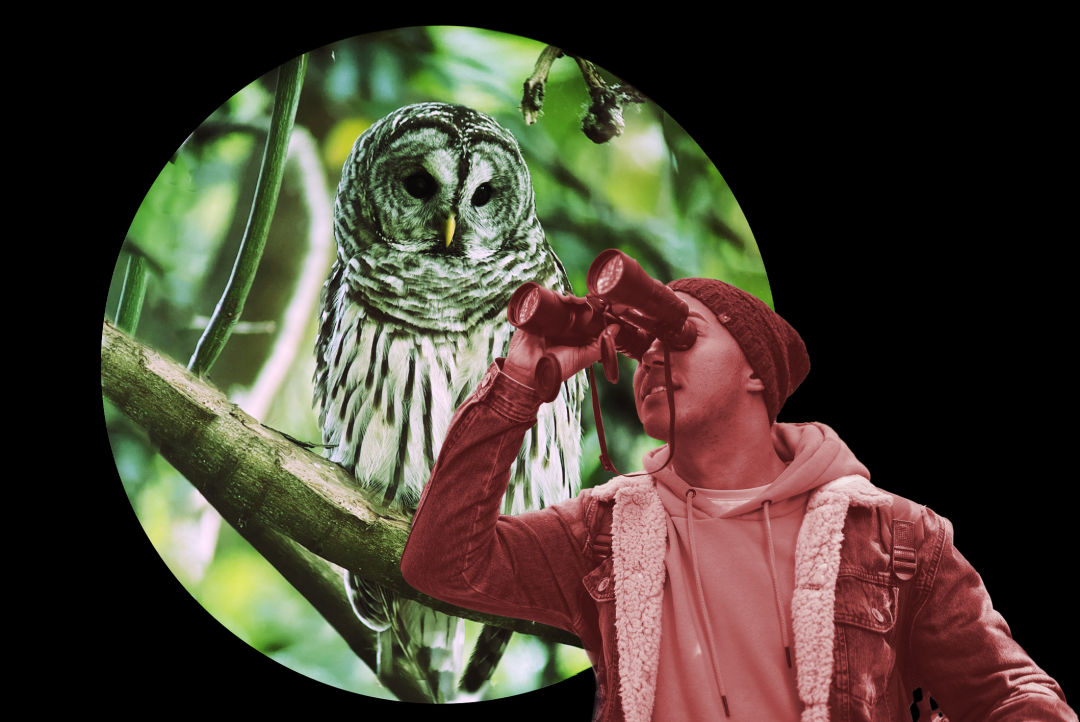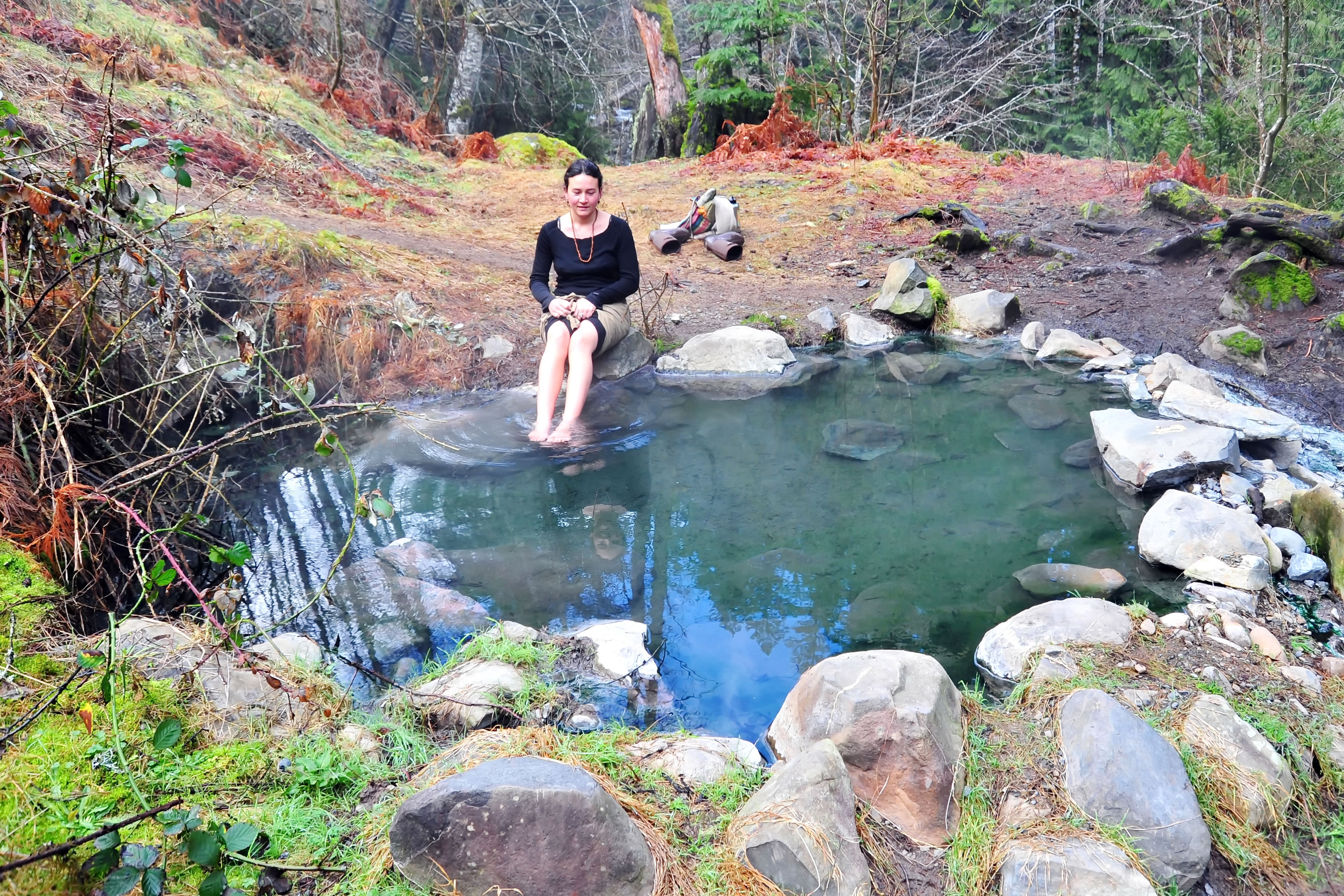How (and Why) to Start Bird-Watching in Seattle

“Look, there’s one!” A woman exclaims, pointing up into a tree. Fifty-seven pairs of eyes follow her finger. We’re on an Owl Prowl in Discovery Park with Birds Connect Seattle, and 10 minutes in, we’ve spotted one.
Our guide, Nathaniel Peters, sets up his telescope, and we take turns peering up close at the barred owl’s face. The chocolate and ash stripes that give it its name mottle like tree bark. If I had come alone, I never would have known it was there.
Learning to spot hidden owls is one of the many reasons to join the Seattle birding community, and you don’t have to go to a large park like Discovery to do it.
“There's not a place in the city where you can go where if you don't wait for just a couple of minutes, you will see or hear a bird,” says Joshua Morris, the urban conservation manager at Birds Connect Seattle. Morris has even led bird walks in Pioneer Square.

Bird watchers on the owl prowl at Discovery Park.
Image: Courtesy Elaine Chuang
“Birds are a real joy in that you always see something,” says Ed Dominguez, the lead naturalist at the Seward Park Audubon Center. Dominguez, who has been birding since he was a child and birding locally since 1987, took me through the Seattle bird calendar:
Early autumn is a good time for songbirds, including migrating vireos, tanagers, and warblers, and local birds whose hormones are triggered because the amount of daylight matches springtime’s. Later in October coots, grebes, and ducks who summered in Canada or Alaska settle on the lakes. Next, winter snows chase hermit thrushes, Townsend's solitaires, varied thrushes, ruby-crowned kinglets, and golden-crowned kinglets down from the mountains. Owls also hoot through the long nights as they pair off and nest. Then the grand finale: spring migration. Fifty-seven million birds flew up here to breed from Central and South America last year.
Learning to recognize all these species takes practice, said Peters, the owl walk leader, but it’s doable and it’s worth it. You learn, he says, that “I'm not just a human in a city, but I'm actually still part of a natural, living, breathing world.”
Birding also introduces you to a human community. That was the case for Elaine Chuang, a coleader on the owl walk. Chuang told me she had become “possessed by this thing” 10 to 12 years ago as her career began to wind down and she “came under the influence of some wonderful birders.”
She had a chance to pay her instruction forward, when six months into the pandemic, a snowy owl came to roost on Queen Anne hill. Every day Chuang would walk to the owl’s hangout with a spotting scope, alcohol wipes, and a step ladder for children, and invite passersby to have a look.
“I just enjoyed so much being able to help introduce something about this amazing animal,” she says. Efforts like Chuang’s are part of the reason the birding community is increasing—especially since the Covid-19 lockdowns. Peters—who posts avian updates on his Instagram @birdmanwithaplan—also leads monthly bird walks in Carkeek Park. Numbers on a good day have risen from five to 10 when he started in 2017 to 15 to 30 now. The walks have also drawn more younger people, more first-time birders, and, slowly, more people of color.

Left: Nathaniel Peters searching for the perfect shot. Right: his photo of a barred owl at Discovery Park.
Image: Olivia Rosane and Courtesy Nathaniel Peters
The stereotypical birder is an older white man or woman. Letting other groups know they are welcome is why Birds Connect Seattle changed its name from Seattle Audubon this March. The name, given John James Audubon’s history of slave-owning, “was one barrier that we identified that was in the way of becoming a more inclusive organization,” Morris says.
Seattle Birds Connect has seen “sustained and growing” interest since the Covid lockdowns. Over at Seward Park Audubon Center, Dominguez says engagement has “been increasing dramatically.” The center is making a point to welcome the diversity of South Seattle, with events for the Nepalese Seattle hiking community, Latino Conservation Week, and Outdoor Afro, among others.
If you’re interested in bird-watching, both Morris and Chuang suggest starting with your own neighborhood. Chuang says the goal is to remain still and “be kind of a detective” so the birds forget you and carry on with their ordinary behaviors. Once you’re ready to travel, the birdiest spots tend to be ones with lots of different habitats like Discovery Park, the Union Bay Natural Area, Seward Park, the Ballard Locks, the Washington Park Arboretum, and Marymoor Park.
To get you started on learning species, Seattle’s bird experts recommend the Cornell Lab of Ornithology's free Merlin Bird ID app, which can help with both visual and audio identifications. For physical books, Dominguez says David Allen Sibley's The Sibley Guide to Birds, Second Edition is the “go-to.” Bird Connect Seattle’s Nature Shop has specialists on hand who can help you pick out binoculars. It’s possible to get a decent pair for around $100–$200. Chuang says to make sure they are waterproof and have a 8X or 10X magnification.
Bird Connect Seattle offers neighborhood bird outings—similar to the Discovery Park Owl Prowl—that are free and don’t require registration. Seward Park Audubon Center also holds a monthly intro to birding class called Morning Treats & Tweets. The Washington Ornithological Society—a statewide group—hosts monthly virtual classes October to May and monthly presentations October to June.
If you too “become possessed by this thing” like Chuang, be prepared to develop not only a greater appreciation for Seattle’s nature, but a desire to protect it.
All of the birders I interviewed spoke passionately about threats facing birds—from climate change and tree canopy loss to outdoor cats, window strikes, and rat poison—and how to counteract them. The Owl Prowl was organized as part of Bird Connect Seattle’s second annual Bird-Safe Seattle Week.
“People take care of what they love, and they love what they know,” Dominguez says.




